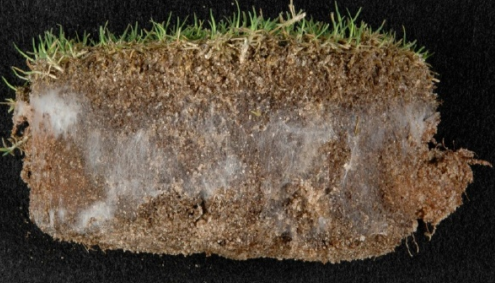Dry Patch of Fine Turf; Causes and Solutions
Many greenkeepers will have experienced localised dry patches developing on their golf greens during the summer months, and the use of wetting agents to treat these areas has become standard practice in golf green maintenance. It is important however, to distinguish dry patch from simple drought stress;
Dry patch is defined as an area of turf that dries out and becomes difficult to rewet even when copious amounts of water is applied. It is usually characterized by the presence of a water repellent soil. The source of this water repellent soil has been linked to fairy ring activity and also the breakdown of organic materials in the root zone as part of natural plant decomposition processes.
Drought stress is different; there is no water repellent soil present and the dryness is a consequence of other turf problems. For example, poor irrigation coverage may lead to drought stressed patches. Poor rooting from a variety of causes is another cause of drought stress, meaning the plant cannot take up the water which is available.
Most observers would agree that the problem of dry patch seems to be more prevalent today than 20 or 30 years ago, and supporting evidence is found in the increasing numbers of wetting agent products that are available primarily to combat the problem. The number of wetting agents continues to grow each year, but not too long ago only a handful existed, and they were used only in certain situations or on the worst hydrophobic soil conditions.
It is believed that we are seeing more potential for localized dry patch for a number of reasons;
Water repellent rootzones have always been present to some extent in sand based greens. But the problem has intensified as the specifications of sand rootzone and topdressings moved away from the inclusion of fine-textured materials. This has been compounded by the amount of play our golf greens receive, and the stress which the grass is subjected to. In the ever increasing desire to provide year round high quality putting surfaces, cutting heights remain lower for longer and fewer inputs of water and fertilizer are made. Inevitably this has an impact on the grass and the rootzone. It is fair to say that water-repellent soils and rootzones will continue to be a significant problem for most golf course managers into the future.
Figure 1. Turf cores taken from adjacent dry patch (right) and normal (left) areas.
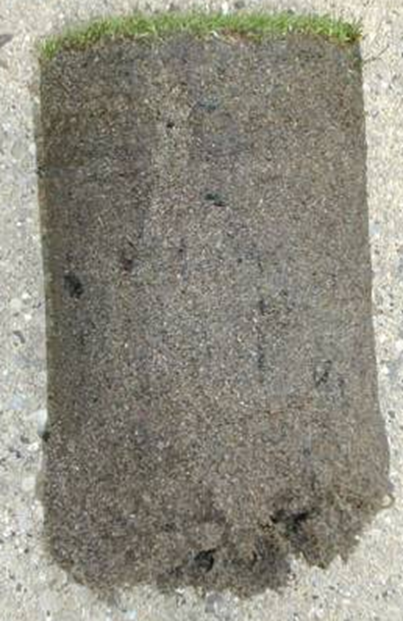 |
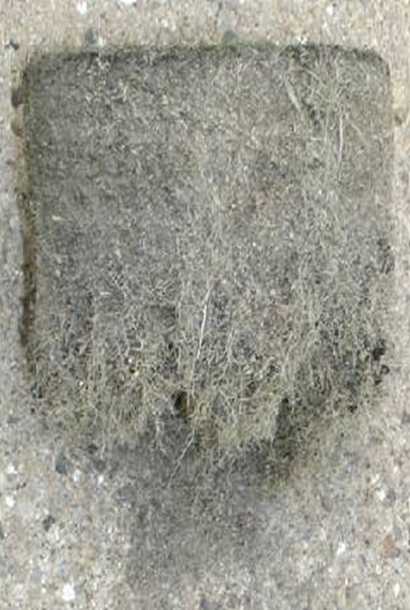 |
Research into dry patch and water repellent soils has shown the presence of water repellent material within the root zone. These materials are waxy hydrophobic compounds that can attach to sand particles within the root zone and render it water repellent. If a soil core is collected from an area of dry patch or water repellent soil it is immediately apparent. An area of lighter, dry material that easily falls apart is seen (Figure 1). Rooting is often compromised, and water dripped onto the surface ‘beads-up’ (Figure 2). However the material above and below the dry zone can be very receptive to water. The hydrophobic portion is often quite localized. If we compare sand particles taken from a hydrophobic region with sand from a healthy rootzone, under an electron microscope, organic deposits stuck onto sand grains can be seen where the sand is hydrophobic (Figure 3). Much less of this can be seen on sand particles taken from the normal turf areas. These water repellent deposits have been extracted from the hydrophobic part of the root zone using solvents and analyzed in the laboratory. They were identified as lipids and waxes which are known to be highly water repellent
The origin of these lipids and waxes coating the sand grains is probably not attributable to a single cause. However, there is strong evidence that previous fairy ring activity could be one factor, and sometimes dry patches on golf greens can be seen in rings and lines across the surface similar to old fairy rings. Also when turf cores are taken from active fairy rings and incubated in moist conditions, the fungal mycelium grows out from a layer in the core which corresponds to the layer in which the most hydrophobic sand is seen (Figure 4).
Linking dry patch formation to fairy ring activity and the production of water repellent substances by fairy ring fungi certainly fits with green keeper experience in the UK but it must be remembered that this is probably not the full story. Water repellent soils exist in agriculture and natural grasslands where fairy rings have not been recorded. They also exist in other situations such as in citrus orchards after fires. Other studies have indicated that fairy ring fungi are generally not involved but the buildup of water repellent materials has come from the production of organic acids created during the natural decomposition processes in thatch. It is likely that there is a range of contributing factors.
Figure 2: Water ‘beading’ over area of hydrophobic soil.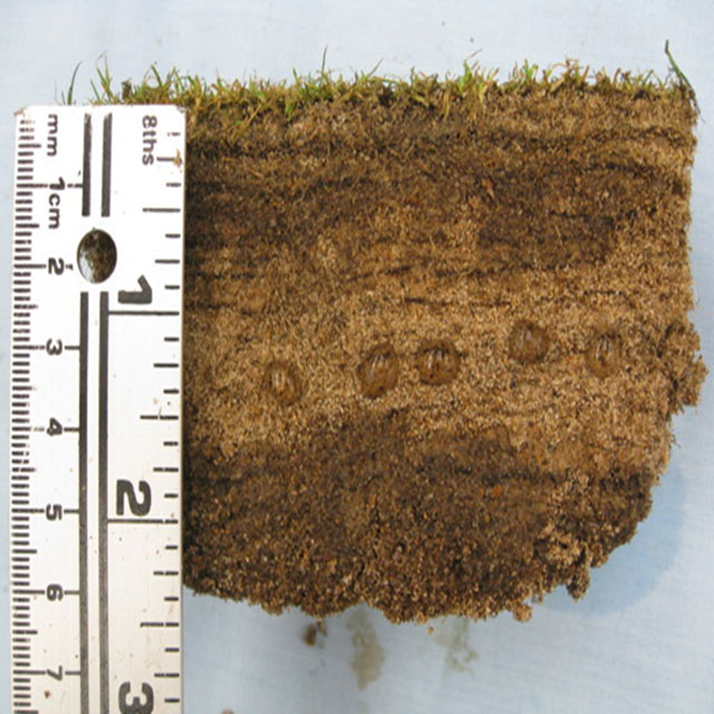
What can be done to prevent and control dry patch? The first step is to identify the primary cause. Is there an actual hydrophobic layer present – or is the turf just drought-stressed. The irrigation system should be checked and moisture meter used to adjust water inputs, cultural practices should also be employed to try and develop a deep turf root system, and alleviate any potential compaction. However, if a water repellent soil is present and this is likely in many cases then this will need to be addressed directly. There are a range of cultural approaches which will help to mitigate the situation; thatch reduction will limit the development of fairy rings. Coring and topdressing with suitable materials will also help replace water repellent soil with fresh material. If dry patch is severe, reduce applications of materials containing iron-sulphate as this material is a desiccant and will further dry out these patches. Dry patch increases stress on the grass plant and so relaxing mowing height and rolling to increase ball-roll speed instead is a good policy. Species conversion promoting bent and fescue grasses which are deeper rooting rather than annual meadow grass which is prone to drought is also a good long term solution.
Figure 3 Organic materials covering sand particles from water repellent turfgrass(left) and relatively clean sand particle taken from normal turf unaffected by dry patch.
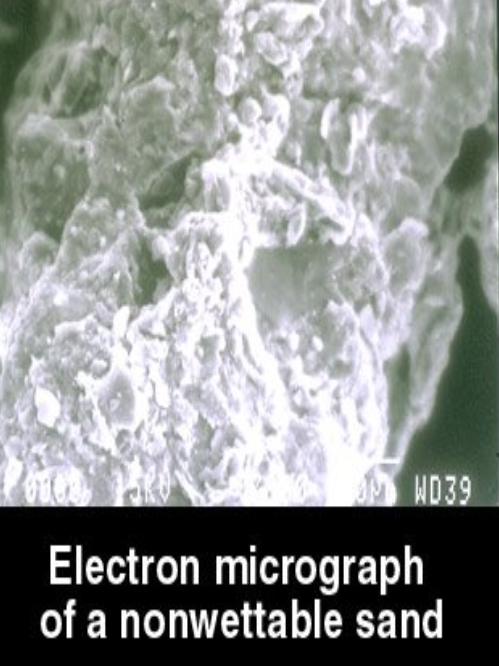 |
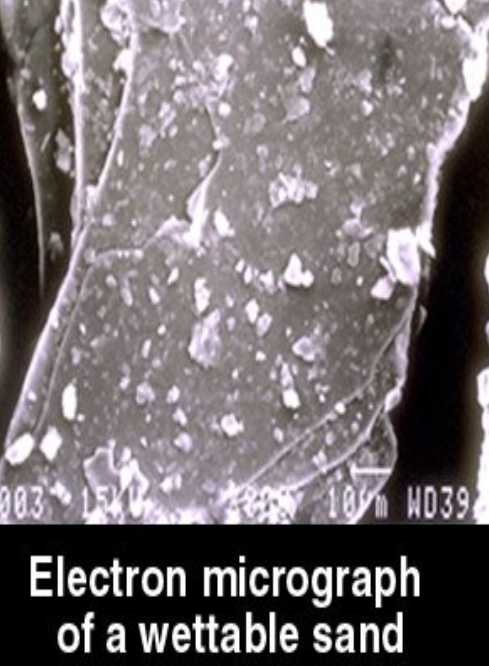 |
The immediate solution is to use wetting agents, and this approach has become standard practice in modern green keeping and they are a very effective treatment for drought stress, dry patch and water repellent soils. The very first wetting agents were used on turf more than 40 years ago and the chosen materials were general purpose detergents and not designed for golf greens. Recent research by Universities and commercial organisations has led to the production of highly active wetting agents that offer an effective treatment for dry patch. The latest wetting agents can reduce dry patch to practically zero even when there are adverse factors such as poor irrigation, poor rooting and compaction. In many cases it is the wetting agent programme that makes all the difference in producing a top quality playing surface especially when it is combined with modern low input fertilizer and watering programmes. There are large differences between the wetting agents on the market however, so consider the choice carefully. Check the research, and select the right one for your situation. Remember a programmed approach of wetting agent application, which starts early in the season will provide the best results.
Figure 4. Incubated turf core showing fairy ring mycelium . Note no mycelium present in surface or deeper rootzone.